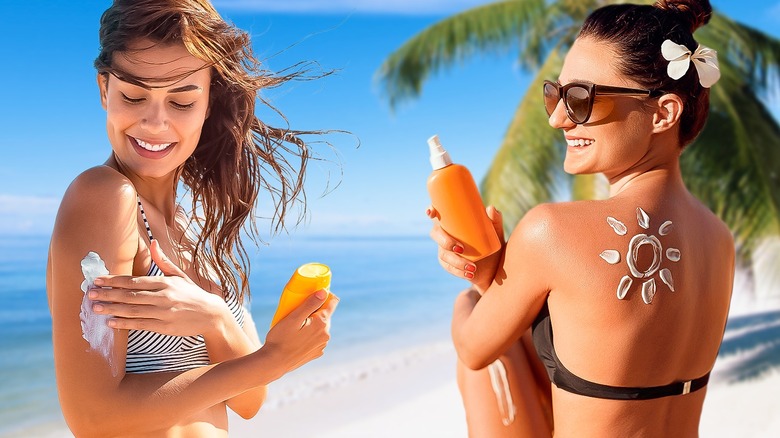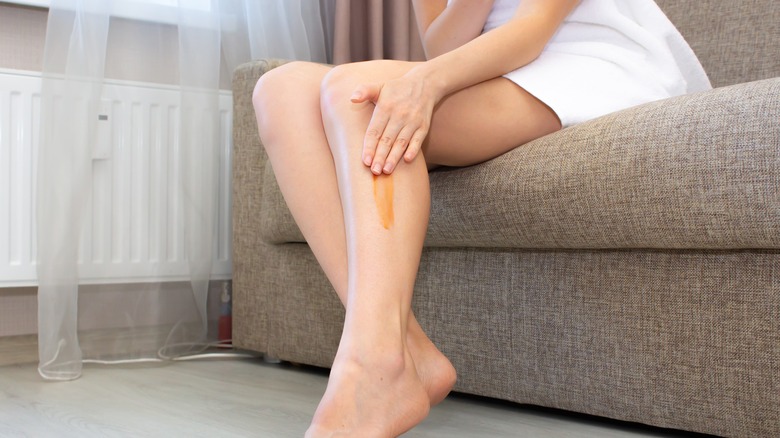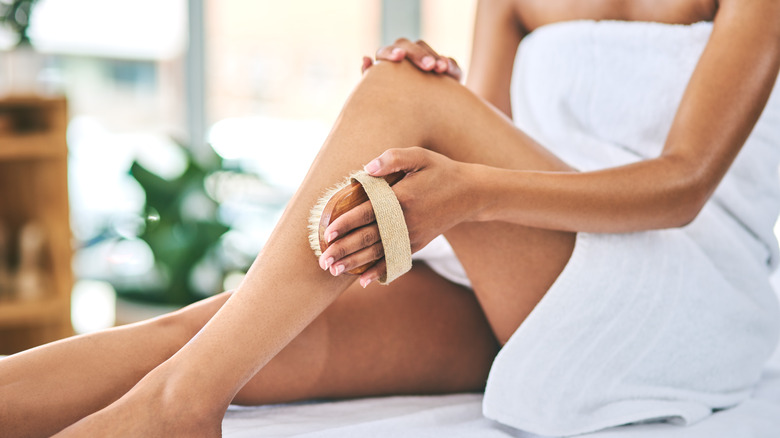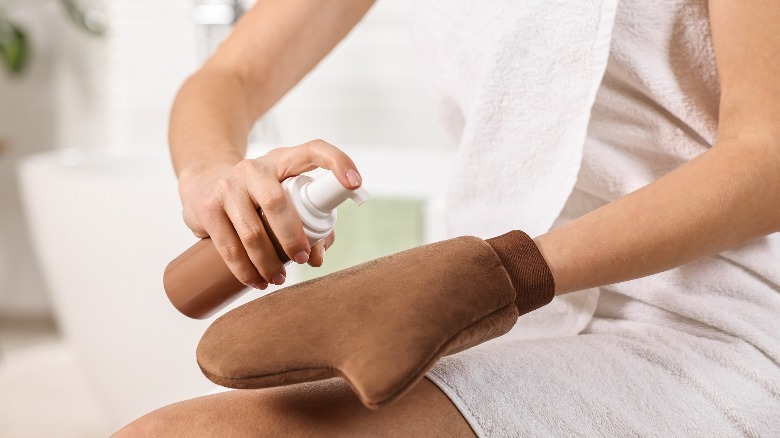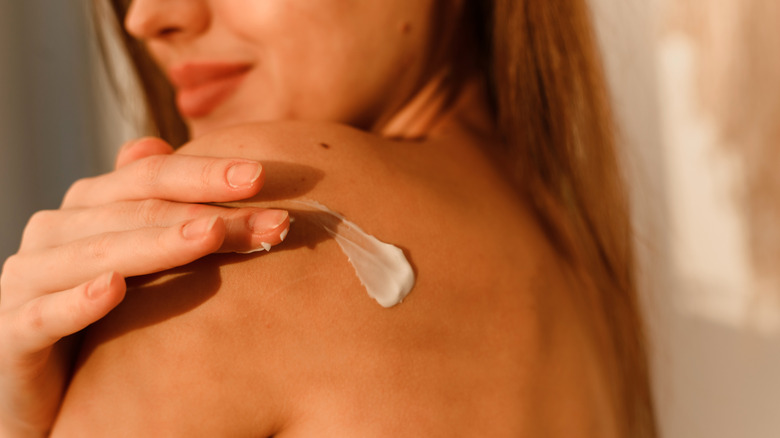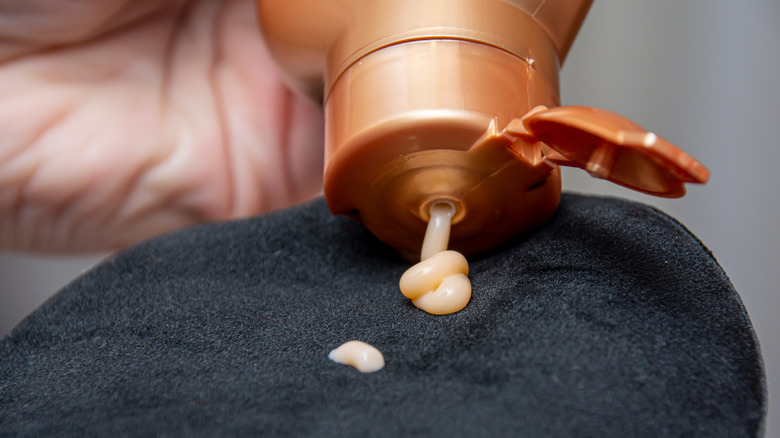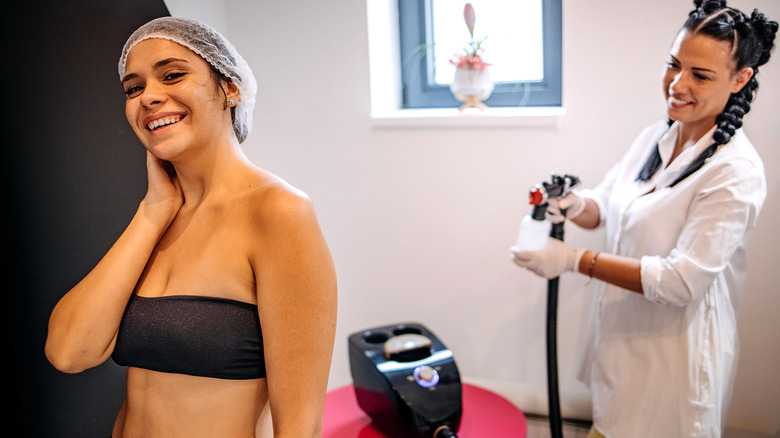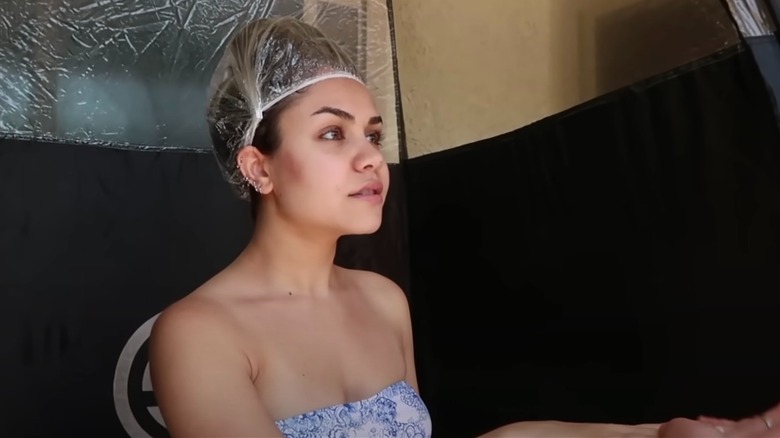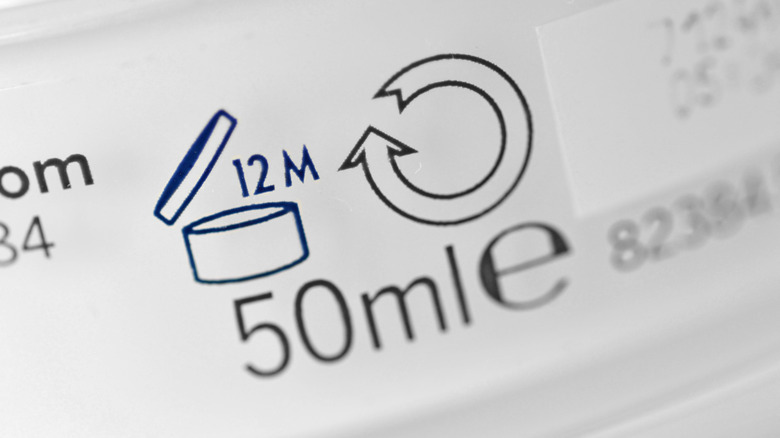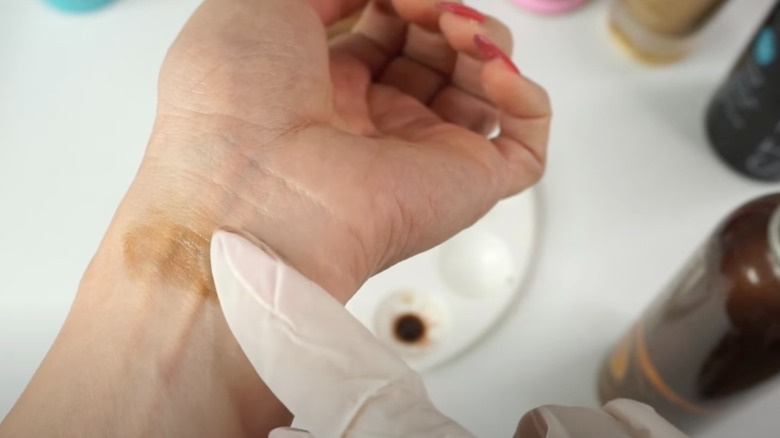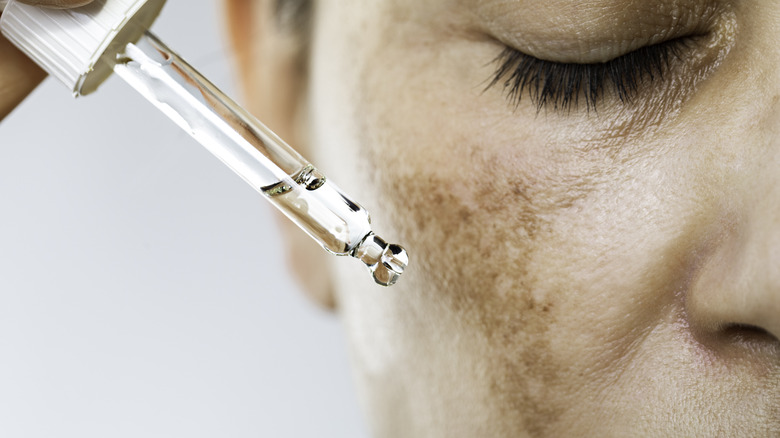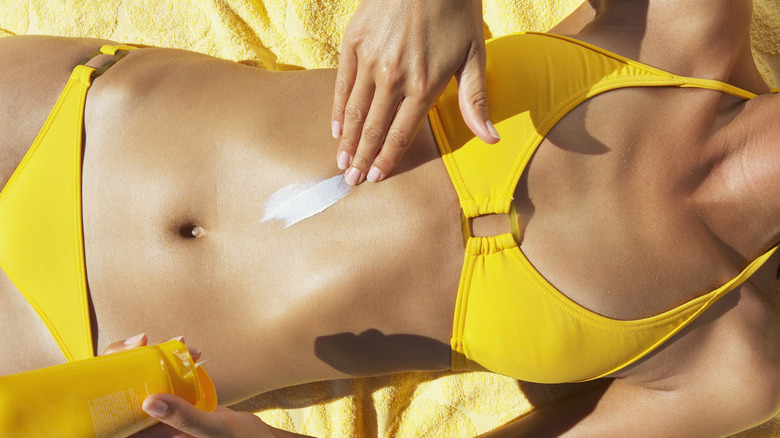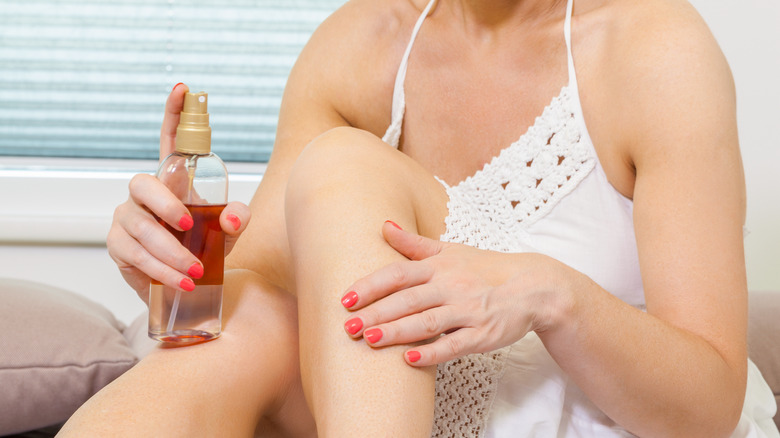Spray-Tan & Self-Tan Mistakes You Don't Want To Make (& How To Fix Them If You Do)
The sunless tanning industry is a multi-million dollar industry that's only set to grow in popularity in the coming years (via American Spa). Although you can head out in the sunshine to catch a tan the traditional way, it comes with the considerable baggage of skin damage and cancer risk. Unfortunately, as it stands, there's no safe way to sun tan without doing harm to your skin, and the long-term side effects like premature aging and wrinkling will usually counter any arguments about the sun tan aesthetic.
Fortunately, sunless tanning is still available to achieve that year-round glow minus UV injury. But if you're a frequent sunless tanner — whether you visit a spray tan technician or DIY that golden bronze at home — you'll already know getting that perfect tan can be a hit or miss. But it doesn't have to be. With a little perseverance and sidestepping of the following common mistakes, a fresh sunless tan awaits.
What is sunless tanning, and how does it work?
The main ingredient of most sunless tanning products is dihydroxyacetone, also known as DHA (via DermNet). As research explains, DHA is a type of sugar that was discovered in the '60s to have staining properties. Through a chemical interaction called the Maillard reaction, the DHA particles react with the amino acids in our skin to create pigments called melanoidins (via Dyes and Pigments).
And as dermatologist Dr. Dray describes in a YouTube video, melanoidins are "chemically similar" to melanin (our natural skin pigment), which gives our skin the tanning effect. The pigments bind to the upper layer of the skin. This is the layer made mostly of dead skin cells and gets dyed by the nearby pigment, turning the outer layer of skin to a tan color.
The same process happens for both spray tanning and self-tanners. The only salient difference between the two is the equipment used. Spray tans involve a tanning booth or beautician who will spray a tanning mist over the body using compressed air. With self-tan, you apply it via lotions, creams, mousse, serums, etc., which you can apply at home.
Not moisturizing correctly
When applying a spray tan, streaking and patching can sometimes occur depending on where and when you moisturize. This is because, according to Be Bronze Studio, moisturizers can prevent DHA from getting fully absorbed by the skin. For this reason, when you tan, it's generally best to leave moisturizer until after you've applied the tan — but there are some exceptions.
Sunless tanners cling to dry spots on the body, like the knees and elbows, so these areas tend to appear darker after the tan sets. By applying moisturizer there, along with other areas where a faux tan might be more obvious, such as your hands, ankles, and toes, your tan will look more natural.
If you've noticed dark areas forming, don't panic. While the tan is still wet, you can use a hand exfoliator or mitt to gently remove some product in the areas that have gotten too dark. Dab away any excess with a cloth. If you don't notice the dark areas until after you rinse the tan off, you can gently exfoliate those areas after soaking them in baby oil.
Skipping exfoliation
Exfoliants help to remove dead skin. And according to research, this helps to allow the DHA to enter the skin at a deeper level, giving you a longer-lasting and more even-looking tan (per Cosmetics & Toiletries). Since the tan clings to the top layer of dead skin, sloughing away any buildup is key to an even-looking glow. So skipping this step might mean you get an uneven finish.
Exfoliating excessively is unnecessary, but a gentle scrub before applying your tan can help cleanse the skin of any residue that may hinder absorption or cause the tan to spread unevenly. However, if you exfoliate too vigorously before tanning, this may result in over-exfoliation, which can cause irritation, redness, and inflammation (via Healthline). If you forget to exfoliate, you can always lightly buff out any uneven areas after the tan is applied and before it's set instead of trying to correct with the tanner itself.
Mistiming your shave
The best rule for shaving around a tan is to not do so 24 hours before or after. There are two reasons for this — firstly, when you shave, like exfoliating, it removes some of the dead cells on the skin.
But, as we've touched on, the pigment that gives you the tan color is sitting in this layer, so you'll effectively be cutting the half-life of your tan when you shave after a tanning session. If you do need a shave and the tan hasn't fully set, give it a day after, exfoliate, and apply some gradual tanning lotion to help build the color back up.
You don't want to shave right before applying tan, either, as you can end up over-exfoliating or run the risk of razor burn. Thus, your tan may turn out patchy. Instead, leaving a window between your shave and tan can give this a chance to settle so that the tanner can go on more smoothly. Pro tip: Do your exfoliation first in your shaving routine to avoid irritation.
Reapplying tan on old tanning products
To avoid uneven, splotchy, and streaky fake tans, applying self-tanning products onto completely clean skin is important. Reapplying the product to old areas where tan had previously been applied can leave an undesired look.
"If you layer new self-tanner over old you're going to end up with an uneven, dirty looking tan," makeup artist and tanning expert Tamar Vezirian tells WebMD. So, it's better to exfoliate the old spray tan away first before adding more so that you get even coverage.
If you need to reapply tanner on top of an old application, one option is going for a lower-concentration DHA product. Gradual tanners or lighter tone tanners are two such options. They tend to have a lower concentration of DHA, so you can use them to correct existing tan lines and other areas that may need additional coverage. They still will add pigment to your skin, so the appearance of dark areas from an old tan won't be as noticeable.
Picking orangey-toned tanners
Different tanning solutions can have better DHA delivery depending on your skin type. However, even if you know what type of tanner is best for your skin, you won't know the color it will provide until you try it. Research in Cosmetics & Toiletries highlights that getting the desired color hinges on your original skin tone.
Lighter skin types, for instance, may find that self-tanning and spray-tanning products leave their skin a bit yellow, so trying a lighter shade at first might help to prevent too obvious of a color mismatch. You may also want to reach for tanning solutions with a green or purple undertone to combat any orange hues.
But if you do end up with an orange tan, don't worry: You can take a warm bath, lather your body in baby oil, and exfoliate to remove most of the tan and try again with a different product.
Applying tanning solution to wet skin
It's essential that before you apply sunless products, you've completely dried off any moisture from your skin. Once the tan has been applied, you'll want to avoid water until the tan has fully developed. Research from the Journal of Investigative Dermatology explains that water can undo the chemical reaction that creates pigments from DHA and amino acids, which means the tan won't develop as well.
If water droplets get on your skin during the developing stages, you can take some tanning solution and gently blend it into the skin on the wet spot to try to correct it. If you shower later and the product has come up patchy, you may be able to correct it by exfoliating around the area and blending it in with fresh tan.
You can also use items around the house to make corrections on the fly. A few drops of diluted lemon juice and baking soda mixed into a paste may help to lift the tan from the skin so that you can buff away any mistakes.
Not moisturizing after the tan
If you want your tan to last longer, moisturizing after is important. Moisturizers contain special ingredients that can help seal in moisture and prevent dry skin — and according to Seattle Sun Tan, you should reach for moisturizers infused with hyaluronic acid for best results.
To upkeep your tan, it's best to moisturize regularly after your tan to maintain the right level of hydration and prevent water loss. If you don't moisturize in the days after your sunless tan, you risk the chances of your tan fading unevenly.
If moisturizing after your tan has slipped your mind, and the tan is starting to look patchy, it's best to go for a warm bath infused with body oil. Then, choose a mild exfoliator and go gently over the dry areas. From there, you can apply a bit of lotion over the dry area and reapply your sunless tanning product if needed.
Forgetting to wash your tanning mitt
If your go-to sunless tanning method involves self-tanning, chances are, you use a tanning mitt. But when was the last time you washed yours? If it's been a while, then it's safe to assume that there is leftover product on your tanning mitt as we speak — and that could be a dangerous mistake for tanning users.
As microbiologist Amy-May Pointer explains to Champneys Health Spa, a test of tanning mitts actually found that after regular use, they're one of the second "worst offenders" out of any beauty tool which "contained a potentially harmful fungus." Namely, uncleaned mitts can lead to the build-up of a fungus called Aspergillus, which can cause Aspergillosis — a "nasty skin infection."
If you've noticed any skin changes like blisters or painful skin patches, you should visit your doctor and throw away the tanning mitt. As the Cleveland Clinic notes, Aspergillosis can't be treated at home and needs proper care, so it's best to prevent it by cleaning your tanning mitt each time you use it.
Applying spray tan too often
For the most part, sunless tanners are considered safe to use when it's used in the proper manner. However, Consumer Reports advises that you should take extra care if you frequent tanning booth sessions or any instance when you might accidentally inhale the product. "Studies have shown that cell damage is worse with repeated inhalation," board-certified dermatologist Chere Lucas Anthony tells Consumer Reports.
As Dr. Anjali Mahto explains to NetDoctor, whenever applying tan, be sure the place is "well-ventilated" to avoid any inadvertent inhalation and be careful not to get it on the mouth, nose, eyes, or any place where it can be absorbed too easily. If you've accidentally breathed it in once or twice, you'll probably be fine. But if you have asthma or any lung conditions, it might be better to take a short break and see your doctor if your condition seems to be getting worse.
Skipping the hair net
When you get a spray tan from a machine, chances are, there is going to be a bit of overspray — or tiny, fine bits of spray tan mist that remain in the air once it leaves the machine. If your hair isn't protected, that overspray can get in your hair.
"The self-tanner ingredient DHA (dihydroxyacetone) chemically reacts with amino acids in the skin protein in a way that changes skin to a brown (really orange-ish) color," cosmetic chemist Perry Rowanowski tells The Cut. "Hair is also made of amino acid-containing proteins. So the DHA in the self-tanner undergoes the same chemical reaction on your hair as on your face."
In other words, your hair can be stained a bronzed-orange hue if not protected. That's why using a hair net while getting a spray tan (especially if you have blond hair) and being cautious of your hairline while applying self-tan products at home is essential. Should any sunless products or spray get on your hair, it'll likely still wash out with a couple of rounds of shampoo.
Putting on perfumes and fragrances
Although the smell of fake tan can be off-putting, there are a few reasons why perfumes may not be a good mix with DHA. One is that fragrances, body sprays, and other products containing alcohol can dilute and fade the tan, giving you light spots on your skin where the fragrance removed the tan — and applying such products before the tan can hinder the solution from fully absorbing.
Fragrances also have a bad rep for causing skin issues, such as allergies and damage to the skin barrier. Research shows there's a wide variety of elements in fragrances that trigger symptoms of contact dermatitis (per Current Treatment Options in Allergy). Mixing DHA and fragrances, for some people, can cause an allergic reaction.
So, ensure you aren't spraying body sprays or perfumes directly onto your skin before or after your tan. If fragrances have caused light spots on the skin from the faded self-tanner, exfoliation may be in order to try to even the tan out. If you feel excessive stinging or experience any allergy symptoms, washing off all the products might be best.
Applying sunless tanning products on hot or humid days
Research from the Journal of Investigative Dermatology reveals that humidity hinders the development of tanning pigment. Not only can high humidity levels destabilize pigment formation, which can affect the development of a long-lasting tan, but it can also cause you to sweat and produce more oils, which can stop the tanning solution from developing properly.
Therefore, it's recommended to wait to apply tanning products on days with extreme humidity, or the result may be that the tan comes out uneven. Or, ensure that there is proper air conditioning in the area you get your tan and that your transportation has AC while driving to and from the salon.
If the humidity affects your tan, you may need to apply a second coat. Wait 30 to 60 minutes after applying the original tan, and if the tan hasn't taken, you can lather on another layer on top in the same way you applied the first. Alternatively, wait a day and apply a gradual tanner over the one you've got, and reapply until you've got the desired color.
Not checking the expiration date
As Well Kept Beauty explains, sunless tanners can lose effectiveness or cause skin issues after expiration, and sometimes even before, if they aren't stored correctly. They should be stored in a dark and cool area if possible to avoid the product getting exposed to light or sun.
Doing this can help to extend their shelf-life. However, if you can't find a clear date on the product, you can also watch out for changes in smell, color, or texture, and follow the general rule of using the product within 12 months from the time of purchase, to ensure you're using an effective and safe DHA tanner (via Healthline).
If you've already or accidentally used an expired product and the tan has come out wrong or miscolored, unfortunately, there's no quick fix. It's better to wash it off, throw out the old tanner, and start again.
Forgetting to patch test if you have sensitive skin
Although rare, there are instances of adverse skin reactions to DHA. The Journal of the Dermatology Nurses' Association reports cases of rashes, cough, dizziness, and fainting linked to spray tans containing DHA. Additionally, sunless tanners can trigger contact dermatitis.
"Any number of topical products, including sunless tanners, may contain active and inactive ingredients that can provoke an irritant or allergic contact dermatitis, so it is important to first test any new product before applying it more broadly," Jeremy Brauer, a New York City-based board-certified dermatologist, tells Allure.
To perform a patch test for self-tanning products, apply a small amount of the tanner on an area of skin that won't easily be washed away and wait 24 hours. If no reaction occurs within this period, the product can be safely used. However, if any skin irritation or reaction occurs, discontinue use immediately. For those with sensitive skin who want a professional spray tan, it's best to seek a hypoallergenic solution without fragrances.
Using body self-tanner on your face
There are a few reasons why you might reconsider using a body tanner on the face. Firstly, the skin on the face and the skin on the rest of the body is, of course, not entirely the same. And since the skin on your face tends to be more sensitive and exposed to the elements on a daily basis, you'll need a product that has different ingredients to best suit your face (via Adore Tanning).
Also, sometimes body tans contain comedogenic (pore-blocking) ingredients, which can break you out. In this case, spray tan artist Jessica Rae advises in a YouTube video to choose tan drops or specialized mousse since these products tend to be less oily, which may help to prevent pore buildup.
"It's really important to apply a light layer of a non-oil-based moisturizer to the problem area prior to application," tanning expert Sophie Evans tells Allure. "I would also recommend applying the moisturizer over the top of your self-tan immediately after application — eczema, acne, and any other dry areas will develop darker, so the moisturizer will dilute the self-tan color and ensure an even tan."
Going to the gym after tanning
Again as we've discussed, moisture plays a huge role in tanning absorption. However, even though it takes DHA approximately eight to 24 hours to develop (per DermNet), it's easy to assume the job is done by the next day and head to the gym. But of course, since the tan hasn't fully set, if you're sweating, it can impede the absorption of the tan.
If you're planning a gym visit, we'd advise you to wait until it's completely developed. It doesn't particularly matter if you go to the gym before tanning as long as you wash and exfoliate properly before applying.
Once your tan is set, take a shower to wash off any excess tan residue. After this, you can add a light layer of baby powder or drying powder around any areas where you're likely to sweat a lot, which will help prevent the tan from rubbing off while you exercise. If you've already set out and noticed it's coming off, you'll probably need to wash it off and restart the process to avoid unevenness.
Not drinking enough water
You might be thinking that if you're moisturizing, that should be adequate for keeping up the longevity of your tan. However, staying hydrated from the inside is also essential in maintaining that bronzed glow and preventing a patchy look from flaky, dry skin.
"One of the best ways to prolong your tan is to keep hydrated," tanning expert Jules Von Hep tells Women's Health. "Drink that water — happy hydrated skin won't shed and will hold onto the colour for longer, if you're on a long-haul flight try to not drink alcohol as this encourages the tan to fade due to the dehydration on the skin."
If you've been moisturizing, but your tan still looks dry and flakey, this might be why. To combat this, you can increase your water intake, but the damage might already be done. You can still increase your water, but you might need to combine this with other restorative skin treatments like barrier creams to help plump the skin.
Not taking areas of hyperpigmentation into account
Interestingly, fake tan can be useful for people with some melanin-associated conditions. However, this may not be true for conditions where there's excess melanin in the skin, such as hyperpigmentation (age and sun spots), according to tan manufacturer Tampa Bay Tan. Although DHA doesn't cause these types of spots — but rather sun exposure — when you add extra pigments into the mix, it can make these spots look darker or more noticeable.
To prevent this and the potential for darkening around existing sun spots, consider applying Vaseline as a barrier to these areas before using a self-tanner. If you've already applied the tan and noticed that your pigmentation spots look darker, you can either remedy them by dabbing on a small amount of diluted lemon juice or apple cider vinegar with a cotton swab to remove some pigment or conceal them with makeup if the latter is too harsh on your skin.
Skipping the sunscreen
Melanin is the body's response against sun damage, and increasing this pigment (even synthetically) can offer some sun protection, so it might be presumed that applying self-tan means you're covered against sun damage. Unfortunately, as dermatologist Dr. Dray explains in a YouTube video, while DHA offers some UVA protection, it won't prevent UVB damage, which causes sunburn.
In other words, it's not enough to offer effective sun protection. Research in the Journal of Clinical and Aesthetic Dermatology explains that it gives you the equivalent of roughly SPF 3, which is far less than most sunscreens. Additionally, they note that there's some evidence that DHA can make the skin more susceptible to light damage during the first 24 hours after application.
So after your tan is set, do remember to apply your sunscreen just as you normally would to reap the benefits of sun-kissed skin without sun damage. If you forget, and your skin feels like it might be burnt, take a cool shower and apply a heavy moisturizer to help the skin heal.
Forgetting that tanning takes time and practice
The very first thing you'll learn as you start your tanning journey is that the process can't be rushed. It's a bit of an art form. Sunless tanning requires patience and attention to detail, which is the enemy of hasty application.
And while correction is possible, as you've seen, prevention is better. And, of course, that's especially true if you're planning to sport your bronzed glow during a special event. Applying just before the occasion might not allow the tan to settle and develop properly, and it doesn't leave much time for correction either.
You need time to experiment with different tanning products, techniques, and tools to find what works best for you. Over time, you'll better understand the process, leading to a more successful and beautiful tan that suits your preferences and complements your skin tone. So, embrace the learning curve and enjoy the journey to achieving a gorgeous, sun-kissed glow.
